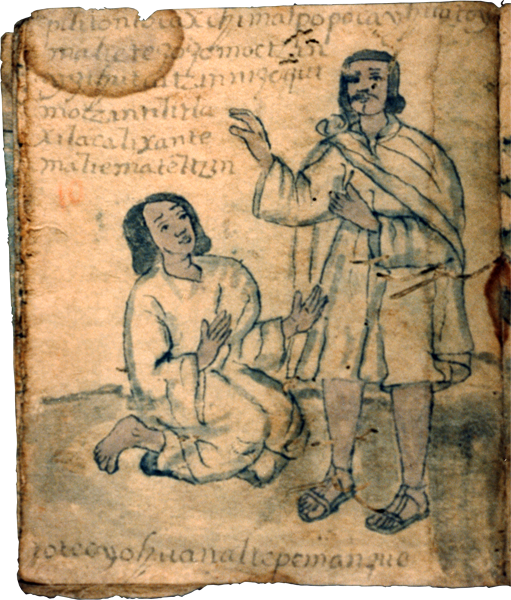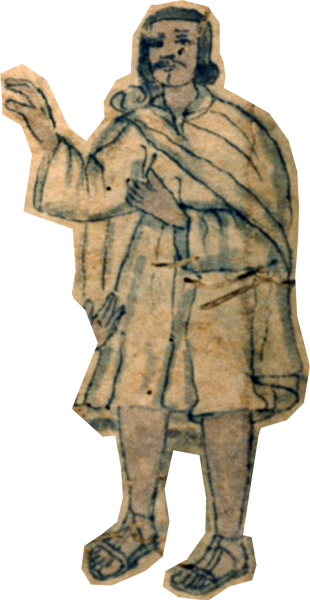f. 11v., indigenous man standing (Spanish colonial times)
This is a detail of an indigenous man standing and gesturing. He is wearing the white cotton clothing typical of the Spanish colonial period. The sandals are a prehispanic layover. The cape tied over his right shoulder is also a prehispanic survival in the garb of elite maies. This is a nobleman, named in the text as don Lucas Chimalpopoca. The indigenous part of this name, meaning Smoking Shield in Nahuatl, was borne by the third ruler of Tenochtitlan. When he took the throne in 1417, Tenochtitlan was a tributary of Azcapotzalco, which was ruled by Tezozomoc (or Teçoçomoc). Their alliance was complemented shortly afterwards with the added figure of Ixtlilxochitl of Tetzcoco, creating the Triple Alliance and setting the stage for the expansion of the Aztec empire. Nobles bearing these names, plus the name of Moteuczoma (better known around the world today), are found all across the Techialoyan genre. In the scene on this page, the woman has the name doña Maria Teçoçomoctzin.
hombre indígena parado (tiempos coloniales Españoles)
Detalle de un hombre indígena parado y haciendo gestos. El esta vistiendo la ropa blanca de algodón típica del periodo colonial Español. Las sandalias son un atuendo prehispánico. La capa amarrada sobre su hombro derecho es también una sobrevivencia en los atuendos de los hombres de élite. Este es un hombre noble, nombrado en el texto como don Lucas Chimalpopoca. La parte indígena de este nombre, significando Escudo de Humo en Nahuatl, fue nacida por el tercer gobernante de Tenochtitlan. Cuando el tomo el trono en 1417, Tenochtitlan era un tributario de Azcapotzalco, el cual estaba gobernado por Tezozomoc (or Teçoçomoc). Su alianza fue complementada un poco después con la figura agregada de Ixtlilxochitl de Tetzcoco, creando una Alianza Triple y estableciendo el escenario para la expansión del imperio Azteca. Nobles portando estos nombres, más el nombre de Moctezuma (mejor conocido alrededor del mundo hoy en día), son encontrados alrededor del género Techialoyan. En la escena de esta página la mujer tiene el nombre doña Maria Teçoçomoctzin.

